
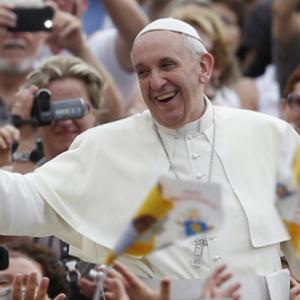
Pope Francis greets the crowd in St. Peter’s Square. Photo by Paul Haring/Catholic News Service
ROME — It’s official, but no big surprise: Pope Francis is now the most-talked-about person on Facebook, according to information released Dec. 10 by the social media giant.
Pope Francis took the top spot, followed closely by Royal Baby George.
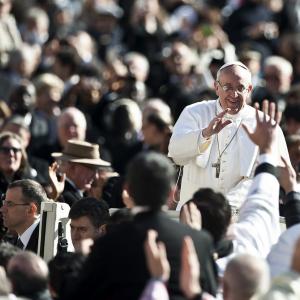
The inauguration of Pope Francis. Photo by Catholic Church (England and Wales)
For the first time in a while, I'm feeling optimistic about the direction of the Catholic church's hierarchy in general and about the office of the papacy in particular. Many authors have written about the plethora of ways in which Pope Francis is hitting the "restart" button for a church so devastated by sexual and financial corruption.
Forgotten, however, is the fact that Pope Benedict XVI had to resign for this breath of fresh air to occur. The pope emeritus deserves recognition for his courageous and humble decision and action. Paradoxically, the conservative pope's nontraditional decision to resign has paved the way for the current pope to begin to mend the broken church structures that have allowed corruption to continue unchecked.

Pope Francis answers journalist questions after the World Youth Gathering. Photo by Paul Haring/Catholic News Service
For more than three decades, the Vatican of Popes John Paul II and Benedict XVI operated on a version of the conservative maxim, “No enemies to the right.”
While left-wing theologians were silenced and liberal-to-moderate bishops were shunted aside in favor of hard-liners, liturgical traditionalists and cultural conservatives were diligently courted and given direct access to the apostolic palace.
But in a few short months, Pope Francis has upended that dynamic, alienating many on the Catholic right by refusing to play favorites and ignoring their preferred agenda items even as he stressed the kind of social justice issues that are near and dear to progressives.
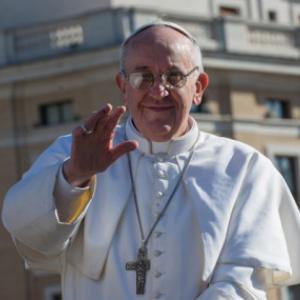
Pope Francis in March. RNS photo by Andrea Sabbadini
In message published on Friday, Pope Francis took the rare step of personally expressing his “esteem and friendship” to the world’s Muslims as they prepare to celebrate the end of the Ramadan fast.
While it is a long-established Vatican practice to send messages to the world’s religious leaders on their major holy days, those greetings are usually signed by the Vatican’s department for interfaith dialogue.
In his message, Francis explains that in the first year of his papacy he wanted to personally greet Muslims, “especially those who are religious leaders.”
Francis’ predecessor, Pope Benedict XVI, had fraught relations with Muslims. In a 2006 speech he quoted a Byzantine emperor who said Muhammad had only brought “evil and inhuman” things to the world, sparking a worldwide crisis in Christian-Muslim relations.
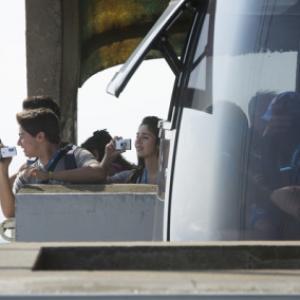
World Youth Day pilgrims take video and photos at the top of Sugarloaf Mountain in Rio de Janeiro July 22. Tyler Orsburn/CNS
Pope Francis spent Tuesday resting following his arrival here in his first international trip as pope during which his car was mobbed by throngs of well-wishers who excitedly closed in on his convoy and prevented the pontiff from reaching his reception ceremony on time.
His arrival animated tens of thousands of young Catholics cramming the Rio city center, as they waved flags, chanted slogans, and swarmed the four-door Fiat he was riding in.
“It was so amazing when he was selected, we just couldn’t believe it. We cried and hugged one another,” Alicia Velazquez said. “I personally want to see if he’s still the same man as simple and humble whom we all knew. I have faith that he’s remained the same.”
Francis’ driver missed lanes that had been cleared on a boulevard, taking the car down a lane that was not lined with fencing and with no uniformed police in sight to control crowds.
Dozens of Vatican and Brazilian plain-clothes security officials had trouble keeping the crowds back but it did not appear to bother Francis. The bulletproof popemobile was left in Rome.
Francis rolled down his back-seat window, waved to the crowd, and touched those who reached inside. He kissed a baby a woman handed to him.
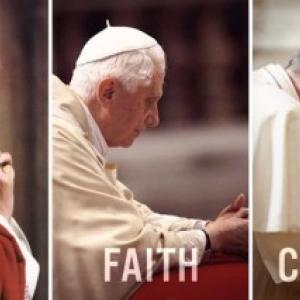
A meme comparing Popes John Paul II, Benedict XVI and Francis. Photo courtesy RNS/CatholicVote.org.
As a millennia-old institution, the Vatican is accustomed to change at a glacial pace. But in the eyes of many outside the church — and even of some within it — the arrival of Pope Francis on the throne of St. Peter seems to have started nothing short of a revolution.
Even Francis himself, in his speech to Rome’s diocese on Monday, said that Christians not only can, but should, be “revolutionaries.”
Now, 100 days into his pontificate, a debate is brewing in Rome over whether Francis has set a distinctly different course from his predecessor, or whether the visible differences in style and personality between Francis and Benedict XVI mask a deeper theological and ideological continuity.
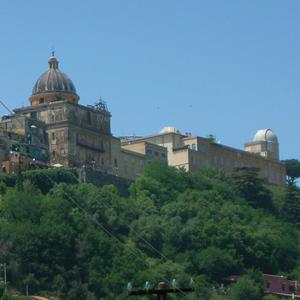
Castel Gandolfo, located 15 miles south of Rome, has been a summer palace for popes since 1624.
Breaking with another centuries-old tradition established by his predecessors, Pope Francis will remain in Rome during the summer and endure the usually stifling heat of the Eternal City.
The Vatican’s chief spokesman, the Rev. Federico Lombardi, announced on Thursday that the pope will not move to the papal villa of Castel Gandolfo, where previous popes usually spent at least part of the summer.
The villa, boasting expansive gardens, a working farm, and a private helipad, was a favorite retreat of Francis’ predecessor, Benedict XVI, who used to spend three months there, from early July to the end of September.
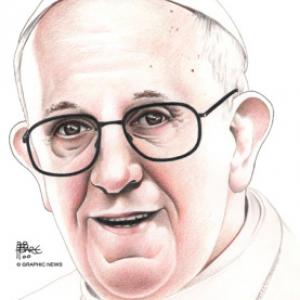
RNS photo courtesy Graphic News.
Is Pope Francis endorsing heresy?
It might look that way from the eye-catching headlines this week that made it appear everyone was bound for heaven — “even atheists!” — thanks to Jesus’ death on the cross.
The passage that prompted the reports came from Francis’ brief homily at the informal morning Mass that he celebrates in the chapel at the Vatican guesthouse.
Speaking on Wednesday, Francis said that as human beings created in the image of God, everyone has a “duty to do good.”
“The Lord has redeemed all of us, all of us, with the Blood of Christ: all of us, not just Catholics. Everyone! ‘Father, the atheists?’ Even the atheists,” he said, answering his own query. “Everyone! And this blood makes us children of God of the first class! We are created children in the likeness of God and the blood of Christ has redeemed us all!”
Cue the jaw dropping and head scratching. Atheists were pleasantly surprised, conservative Catholics were dazed and confused, and the pope’s comments raced around the Internet; for a while they were the second-most shared piece on Reddit.
So was Francis preaching a form of “universalism?" That is the unorthodox teaching that says, essentially, that all faiths are equal and all are going to heaven, especially if you are nice to people here on earth. It’s also a heresy that Francis’ predecessor, Benedict XVI, spent a career quashing every time he thought he thought he spied a hint of it in some theologian’s writings.
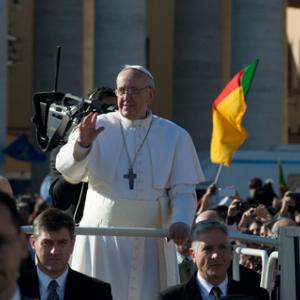
Pope Francis waves from the pope-mobile during his inauguration Mass. RNS photo by Andrea Sabbadini
In his two months as leader of the world’s 1.2 billion Roman Catholics, Pope Francis has captured the imagination not only of his own flock, but that of the world at large.
Many of us, Catholic or not, seem to hang on his every word both for spiritual guidance and clues to the personality of the man we collectively are getting to know as perhaps the most recognizable Christian on the planet.
Two new books offer further insights into the heart and mind of the former Jorge Bergoglio through his own words. Both are fascinating reads for papal watchers and news junkies alike, painting a vivid portrait of the man, the leader, and the humble follower of Christ.
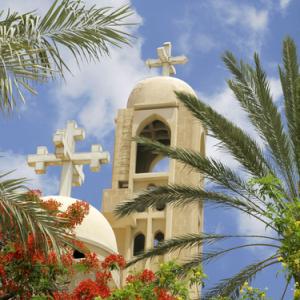
Copts make up ten percent of Egypt's population. Photo courtesy George Nazmi Bebawi/shutterstock.com
Pope Francis on Friday met with Pope Tawadros II, head of Egypt’s Coptic Orthodox Church, an encounter that brought the number of popes within the Vatican walls to three this week.
Benedict XVI, the emeritus pope, returned to the Vatican on May 2, two months after his resignation, while Tawadros is only the second Coptic pope to visit the Vatican, after the historic visit of Pope Shenouda III to Pope Paul VI in 1973.
Tawadros — on his first foreign trip since he was elected in November — is staying at the Vatican’s guesthouse where Pope Francis is also living. Benedict is now living in a revamped convent a 5-minute walk away, but there were no plans for the two men to meet.
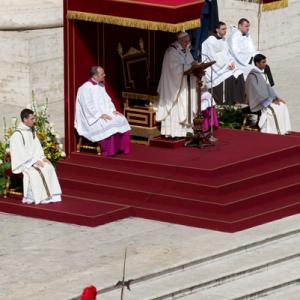
Pope Francis issued a powerful call for the protection of the environment and society’s most vulnerable. Photo courtesy RNS.
When you’re the pope, few things matter as much as what you say and, especially, where you say it.
From the pulpit of St. Peter’s Basilica or an outdoor altar erected in St. Peter’s Square, popes can command global media attention. Pope Francis, however, has settled in with a smaller congregation for his homilies that’s more in keeping with his low-key style.
Every day at 7 a.m., Francis celebrates Mass in the chapel of the Casa Santa Marta, the Vatican’s hotel-style guesthouse he has chosen to call home instead of the luxurious papal apartments. His brief, colorful homilies are delivered to small groups of Vatican workers, from policemen to doctors and bank employees.
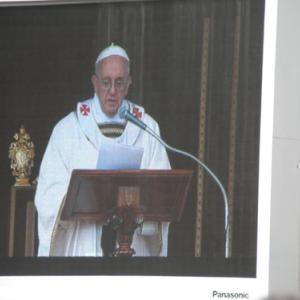
Pope Francis, emipress / Shutterstock.com
From the very first moment of his unexpected election as Pope Francis, Cardinal Jorge Bergoglio of Argentina has embraced a series of small departures from established tradition.
He took his papal name from a great nonconforming saint of the Middle Ages — and one that no other pope in the history of the Roman Catholic Church has taken. He then refused to stand on an elevated platform that would separate him from his “brother cardinals,” and asked the people of Rome to bless him rather than receive his blessing. He even insisted on returning to his hotel to settle his account (as though his credit were in any doubt).
Everyone who knew Bergoglio saw in him an unconventional and even unpredictable figure. He lived in Buenos Aires in a modest apartment rather than in the archbishop’s palace. He dispensed with a private limousine and took public transportation to work. He even cooked his own meals at home in his own kitchen.
Now, as pope, he has continued this pattern by ignoring long-settled traditions of what a pope should wear, where he should reside, and how he should conduct himself in public functions. Francis has chosen not wear the gold papal cross to which he is entitled, instead wearing the more simple cross he wore in Argentina. He also seems satisfied with normal men’s footwear, avoiding the elegant red loafers Pope Benedict normally wore in public.
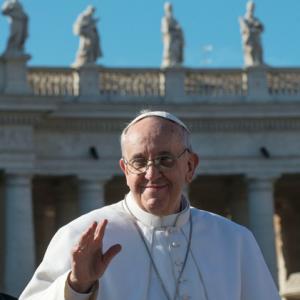
Pope Francis waves to the crowd in St. Peter’s Square at the Vatican. Photo courtesy RNS.
Pope Francis has won widespread acclaim thus far in his nascent papacy with popular gestures like washing the feet of juveniles during Holy Week and refusing many papal perks. But now comes the hard part of his new job: reforming the Vatican.
The Roman Curia, as the central administration of the Catholic Church is known, has been riven by scandals and allegations of infighting and careerism, which helped undermine Pope Emeritus Benedict XVI’s reign and reportedly pushed him to resign.
The dysfunction was so bad that reforming the Curia became a rallying cry for many cardinals at the conclave that elected Francis. But will he deliver on the promise of reform?

Pope Francis waves during his inauguration Mass at St. Peter’s Square at the Vatican. Photo courtesy RNS.
He has been Pope Francis for less than a month, but the keep-it-simple prelate from Argentina is a wow with American Catholics — at least for now.
The tables may turn on Francis once media attention moves from his no-fuss style to his substantive actions, said a Vatican expert Wednesday.
The former archbishop of Buenos Aires has an 84 percent favorable rating among U.S. Catholics, including 43 percent who hold a very favorable view of him, according to a new survey by the Pew Forum on Religion & Public Life.
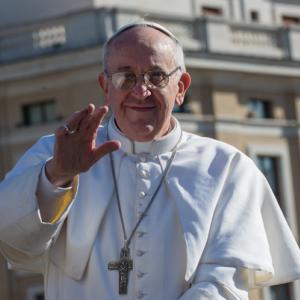
Pope Francis waves during his inauguration Mass at St. Peter’s Square at the Vatican. Photo courtesy RNS.
The Vatican on Friday dismissed criticism of Pope Francis’ decision to wash the feet of two women during a Maundy Thursday Mass at a Rome youth prison.
The move has come under fire from Catholic traditionalists who say that the rite is a re-enactment of Jesus washing the feet of the 12 apostles before his death, and thus should be limited only to men.
Traditionally, popes have washed the feet of 12 priests during a solemn Mass in Rome’s St. John Lateran Basilica.

Pope Francis waves from the pope-mobile during his inauguration Mass. RNS photo by Andrea Sabbadini
Pope Francis on Thursday washed the feet of 12 young inmates, including two girls and two Muslims, during a Maundy Thursday Mass at a youth detention center in Rome.
The Argentine pontiff, who has shown an eagerness to break with tradition in the two weeks since his election to the papacy on March 13, chose to celebrate the rite in the Casal del Marmo prison in northwest Rome, rather than in the traditional venue of the St. John Lateran Basilica.
Francis has repeatedly stated his desire to bring the papacy and the church closer to the poor and the marginalized.
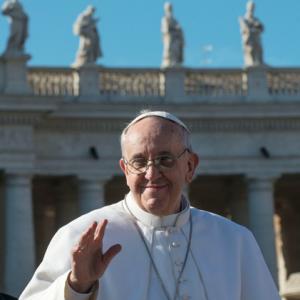
Pope Francis waves to the crowd in St. Peter’s Square on Tuesday at the Vatican. Photo courtesy Religion News Service.
In his first general audience since his election to the papacy, Pope Francis on Wednesday urged Catholics to leave their comfort zone to search for “lost sheep.”
As the Catholic Church prepares for Easter and celebrates the rites of Holy Week, Francis told around 20,000 people in St. Peter’s Square to avoid “a tired and routine way of living the faith,” and resist “the temptation to withdraw into pre-established patterns that end up closing our horizon” to God.
“We must not be content to remain in the enclosure of the 99 sheep; we have to step outside, to search for the lost sheep,” he added, referring to a parable of Jesus.
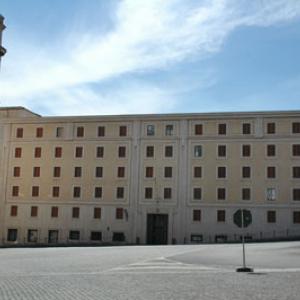
Photo by Rene Shaw
VATICAN CITY — Shunning the spacious papal apartment used by his predecessors, Pope Francis has chosen to continue living in the Vatican guesthouse where he has been staying since the beginning of the conclave.
The Vatican’s chief spokesman, the Rev. Federico Lombardi, explained on Tuesday that Francis will live “until further notice” in a suite in the Santa Martha Residence, a modern Vatican guesthouse for priests and bishops who work in the Roman Curia or who are visiting the Vatican for meetings and conferences.
Francis made his intentions clear on Tuesday morning, while celebrating Mass in the residence’s chapel for its permanent guests, who occupy about half of the residence’s 130 or so rooms.
The pontiff’s choice is a consequence of his desire to adopt a “simple” living arrangement that allows him “to live in community” with other priests and bishops, Lombardi explained.
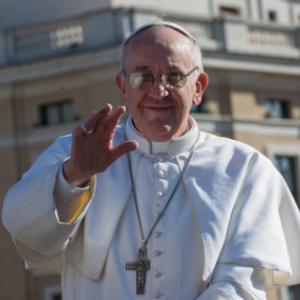
Pope Francis waves during his inauguration Mass at St. Peter’s Square on Tuesday at the Vatican. Photo courtesy RNS.
Since the moment of his election on March 13, Pope Francis has been warmly embraced by his own flock and even the media and the wider public in a way his bookish predecessor, Benedict XVI, was not.
Such an effusive welcome is especially good news for Catholic leaders who spent years fending off criticism of Vatican dysfunction under Benedict and a cloud of scandal and crisis at home. And the hot start for Francis is also crucial in building up a reservoir of good will that will be needed when the new pope refuses to bend on unpopular teachings or commits a gaffe of his own. Polls show that anywhere from 73 percent to 88 percent of American Catholics say they are happy with the selection of Francis, as opposed to about 60 percent who were happy with the choice of Benedict — and many of those are extremely pleased with the new pope.
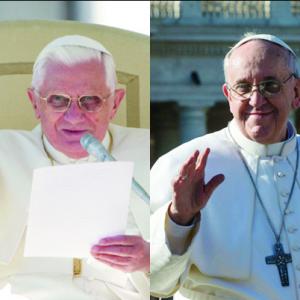
'Pope Emeritus' Benedict XVI (left), and Pope Francis. Photo courtesy Religion News Service.
Now that the cardinals have elected and installed their new boss, Pope Francis can get to work being the Roman Catholic pontiff, with his next order of business doing something no other pope has done in centuries: meet the guy he replaced.
Benedict’s resignation — the first by a pope in 600 years — paved the way for the conclave that elected Francis on March 13, but it also created an almost unprecedented potential for confusion and division in a church hierarchy that has room for only one pope at a time.That will happen on Saturday, when Francis is scheduled to travel a few miles outside Rome to the hilltop town of Castel Gandolfo, the summer papal residence where Benedict XVI has been staying — out of sight — since he resigned and left the Vatican on Feb. 28.
“Benedict XVI could turn into a shadow pope who has stepped down but can still exert indirect influence,” said Hans Kung, the dissident Swiss theologian and friend (as well as frequent critic) of Benedict’s since he and the former Joseph Ratzinger were up-and-coming theologians.
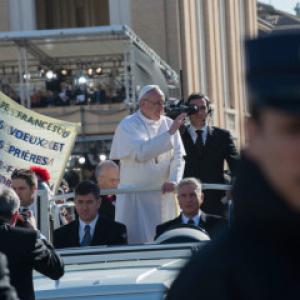
Pope Francis waves during his inauguration Mass at St. Peter’s Square on Tuesday. RNS photo by Andrea Sabbadini
VATICAN CITY — Pope Francis on Friday called for more intense dialogue between religious leaders, particularly Muslims, as he tries to recalibrate relations between the world’s two largest religious groups.
Speaking in the Vatican’s majestic Sala Regia, the Argentine pontiff said that part of his mission is to connect “all people, in such a way that everyone can see in the other not an enemy, not a rival, but a brother or sister.”
In a meeting with Vatican diplomats and foreign leaders, Francis also reaffirmed the church’s commitment to protect the poor and the environment, an early theme in his young pontificate.
“Fighting poverty, both material and spiritual, building peace and constructing bridges: these, as it were, are the reference points for a journey that I want to invite each of the countries here represented to take up,” the pope said.
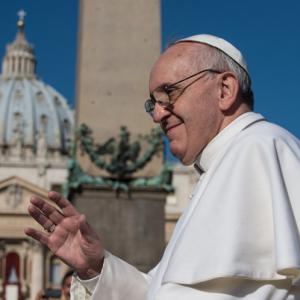
Pope Francis at his inauguration Mass at St. Peter’s Square on Tuesday at the Vatican. Photo courtesy RNS.
Even as a non-Catholic, I was filled with hope when an Argentine cardinal said to be passionate about serving the poor stepped onto the balcony overlooking St. Peter’s Square as Pope Francis.
By taking the name of a church reformer, the former Cardinal Jorge Bergoglio promised a better day for an ossified institution whose people beg for hope while hierarchs defend medieval power and pomp.
By standing in silence and bowing his head for the crowd’s blessing, Francis showed a humility that could inspire believers grown weary of Roman arrogance. In greeting the crowd, the new pope showed a common touch that could repurpose a global movement from being lost in scandal and self-serving.

MattiaATH / Shutterstock.com
Editor's Note: Pope Francis delivered the following homily at his inaugural Mass on Tuesday, emphasizing the need to protect the poor and the environment.
Dear Brothers and Sisters,
I thank the Lord that I can celebrate this Holy Mass for the inauguration of my Petrine ministry on the solemnity of Saint Joseph, the spouse of the Virgin Mary and the patron of the universal Church. It is a significant coincidence, and it is also the name-day of my venerable predecessor: we are close to him with our prayers, full of affection and gratitude.
I offer a warm greeting to my brother cardinals and bishops, the priests, deacons, men and women religious, and all the lay faithful. I thank the representatives of the other Churches and ecclesial Communities, as well as the representatives of the Jewish community and the other religious communities, for their presence. My cordial greetings go to the Heads of State and Government, the members of the official Delegations from many countries throughout the world, and the Diplomatic Corps.
In the Gospel we heard that "Joseph did as the angel of the Lord commanded him and took Mary as his wife" (Mt 1:24). These words already point to the mission which God entrusts to Joseph: he is to be the custos, the protector. The protector of whom? Of Mary and Jesus; but this protection is then extended to the Church, as Blessed John Paul II pointed out: "Just as Saint Joseph took loving care of Mary and gladly dedicated himself to Jesus Christ’s upbringing, he likewise watches over and protects Christ’s Mystical Body, the Church, of which the Virgin Mary is the exemplar and model" (Redemptoris Custos, 1).
How does Joseph exercise his role as protector? Discreetly, humbly and silently, but with an unfailing presence and utter fidelity, even when he finds it hard to understand. From the time of his betrothal to Mary until the finding of the twelve-year-old Jesus in the Temple of Jerusalem, he is there at every moment with loving care. As the spouse of Mary, he is at her side in good times and bad, on the journey to Bethlehem for the census and in the anxious and joyful hours when she gave birth; amid the drama of the flight into Egypt and during the frantic search for their child in the Temple; and later in the day-to-day life of the home of Nazareth, in the workshop where he taught his trade to Jesus.
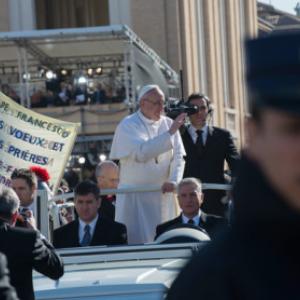
Pope Francis waves from the pope-mobile during his inauguration Mass on Tuesday. RNS photo by Andrea Sabbadini
VATICAN CITY — Pope Francis issued a powerful call for the protection of the environment and of society’s most vulnerable during his formal installation Mass at the Vatican, while qualifying his papal power as a “service” to the church and to humanity.
The pope on Tuesday celebrated a solemn Mass in St. Peter’s Square in front of an estimated 200,000 people, as well as political and religious leaders from all over the world.
During the Mass, Francis received the symbols of his papal authority over the world’s 1.2 billion Roman Catholics: the pallium, a lamb’s wool stole that recalls Jesus as the Good Shepherd, and the “ring of the fisherman.”
In keeping with the low-key style that has been the hallmark of his pontificate so far, Francis presided over a somewhat simpler, and definitely shorter, rite than the one that marked the start of Benedict XVI’s reign in 2005.
Francis was slowly driven around a sun-drenched St. Peter’s Square in an open-top car, shunning the bulletproof, air-conditioned popemobile preferred by his predecessors. At one point, he asked to stop the car and got out to bless a disabled person.
In his homily, delivered in Italian, Francis described the church’s mission as “respecting each of God’s creatures and respecting the environment in which we live.”
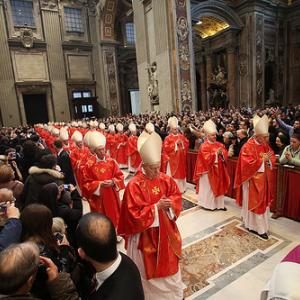
Cardinals attend a solemn Mass at St. Peter’s before the conclave. Photo courtesy Religion News Service.
Last Sunday night, the Rev. Thomas Rosica was walking through the Piazza Navona in Rome’s historic center when he bumped into Cardinal Jorge Bergoglio, who he has known for years. Bergoglio was walking alone, wearing a simple black cassock and he stopped and grabbed Rosica’s hands.
He had reason to be worried. Two days later, on Tuesday evening, he and 114 other cardinals entered the conclave to elect a successor to Benedict XVI; a little more than 24 hours and five ballots after that, Bergoglio emerged on the balcony of St. Peter’s Basilica as Pope Francis. “I want you to pray for me,” the Argentine cardinal told Rosica, a Canadian priest who was assisting as a Vatican spokesman during the papal interregnum. Rosica asked him if he was nervous. “A little bit,” Bergoglio confessed.
It was a surprising outcome, and even if Bergoglio suspected something was up, few others did, including many of the cardinals in the Sistine Chapel with him.
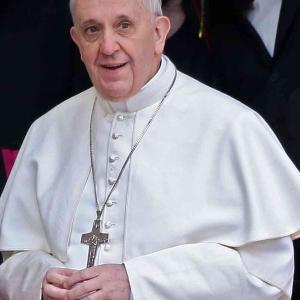
Pope Francis I. Photo courtesy Patheos.
Only a day into his papacy, and I’ve got to admit, Pope Francis has my attention. In an editorial piece on the Sojourners website today, Jim Wallis cited a surprising and very heartening quote from the new pontiff, especially for those looking in from the outside as non-Catholics. Here’s an excerpt from one of his first public addresses:
“We have to avoid the spiritual sickness of a self-referential church. It’s true that when you get out into the street, as happens to every man and woman, there can be accidents. However, if the church remains closed in on itself, self-referential, it gets old. Between a church that suffers accidents in the street, and a church that’s sick because it’s self-referential, I have no doubts about preferring the former.”

Eva Peron on the balcony of the Casa Rosada in 1951. Photo courtesy Religion News Service / Wikimedia Commons
In 1974, when the Rev. Jorge Bergoglio was the top Jesuit in his native Argentina, a former nightclub dancer named Isabel Peron came to head the nation – an accidental and weak president.
Isabel Peron served less than two years in office before a right-wing military coup placed her under house arrest, and launched a seven-year campaign of torture and killings of tens of thousands of trade unionists and other leftists: Argentina’s Dirty War.

Cardinal Jorge M. Bergoglio, now Pope Francis, celebrating mass in Buenos Aires. Photo courtesy Religion News Service.
Jesuits are bound by oath not to seek higher office in the Roman Catholic Church, and now one of them has been elected to its highest office: Bishop of Rome, Vicar of Christ, Pontifex Maximus.
“On the one hand, Jesuits aren’t supposed to be in positions of authority,” said the Rev. Joseph Fessio, a Jesuit and founder of Ignatius Press. “On the other hand, they’re supposed to be obedient to the church.” Pope Francis, the first Jesuit to become pope, not only represents a paradox for the papacy, but also the larger history of the Society of Jesus, as the Jesuits are formally known.
The Jesuits have played a key role in the history of the church. For centuries, they have served as its leading missionaries, founded its most prestigious universities and committed themselves to alleviating the deepest poverty.
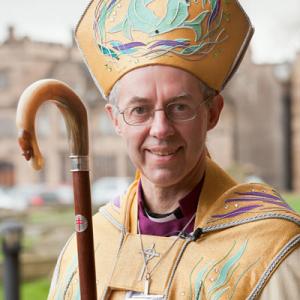
The Right Rev. Justin Welby will be installed as Archbishop of Canterbury
With the words “Habemus papam” — we have a pope — Roman Catholics had a new leader, and the wider world had a new ministry to watch.
The direction the new pope takes his flock is of great importance for committed Catholics, but the papacy is also closely watched by other faiths. The pope wields vast influence as the world’s most powerful moral leader and the public face of Christianity.
Leaders of other faiths appeared to embrace the selection cautiously, not unlike some Catholics themselves, offering prayers and congratulations, but also using the opportunity to lay out their own hopes for the new pontiff. Pope Francis of Buenos Aires, formerly Cardinal Jorge Bergoglio, emerged from the conclave as the first pope from outside Europe in modern times, the first Jesuit, the first from Latin America, and the first named Francis, in honor of St. Francis of Assisi, who dedicated his life to helping the poor.
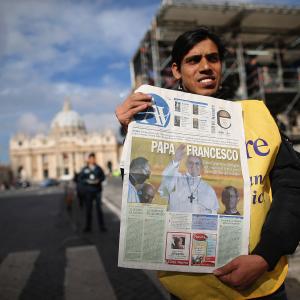
A man sells newspapers outside St Peter's Square on Thursday morning. Dan Kitwood/Getty Images
When I heard about the white smoke on Wednesday, I wrote on my Facebook wall: “Habent Papum.” My own church doesn’t use Latin, so I had to use Google translate to figure out how to change the “We have a pope” of “Habemus Papam” into “They have a pope.” I got a few good laughs for my cleverness before a Catholic friend humbly reminded me that it wasn’t just their pope, and that I’d have to deal with him too ... he has no idea how prophetic his words have turned out to be.
You see, I didn’t expect to tune in at all to the election of the pope. I was raised in the Catholic Church and received its early sacraments before my family joined the Episcopal Church (my father’s tradition). I spent plenty of time in high school and after defending its practices and traditions against atheists and Protestant friends and colleagues, and I more than made up for that by pressing hard on my Catholic friends on the nuances I didn’t understand. But mostly I only paid attention when the Catholic Church said something publicly or took a political stand on an issue I cared about.
But on Wednesday, the white smoke got in my eyes, and rather than confusing my sight, it’s made things a little clearer.
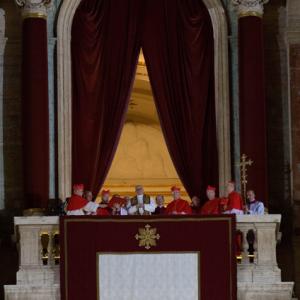
Newly elected Pope Francis appears on the balcony of St. Peter’s Basilica on Wednesday. Photo courtesy Religion News Service.
Jews worldwide welcomed newly elected Pope Francis as a friend on Wednesday, and pointed in particular to his sympathetic and strong reaction to the 1994 bombing of a Jewish center in his native Argentina — the deadliest bombing in the country’s history.
As Cardinal Jorge Mario Bergoglio, the archbishop of Buenos Aires, Francis “has had a warm relationship with the Jewish community of Argentina, and enjoyed close friendships with many prominent rabbis,” said Rabbi David Rosen, international director of interreligious affairs at the American Jewish Committee. “As far as I have heard and read in the few minutes since he was elected pope, he has shown deep signs of respect and friendship towards the Jews,” said Riccardo Di Segni, the chief rabbi of Rome. “It’s a good starting point.”
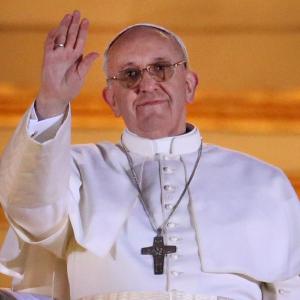
Newly elected Pope Francis waves to the St. Peter's Square crowd. Peter Macdiarmid/Getty Images
Francis. Pope Francis. This could be good news for the Catholic Church, for the whole church, and for the world. Let’s hope and pray so.
Jorge Bergoglio, the Argentinian cardinal from Buenos Aires, will be the first pope from Latin America and the first outside of Europe in a millennium. That’s good news from the start. And the world is now learning about the 76-year-old new pontiff whose election caused the white smoke to rise in the night skies of Rome to the cheers of tens of thousands of people in St. Peter’s Square. A Jesuit scholar, he seems to be a humble man who lives simply, choosing to live in a small apartment instead of the archbishop’s palace, and travel on buses and trams instead of in the church limousine.
Will simplicity and social justice become the witness of the Roman Catholic Church around the world — and will it emanate from the first pope from the Global South, which is clearly the growing future of the church? What good news that would be.
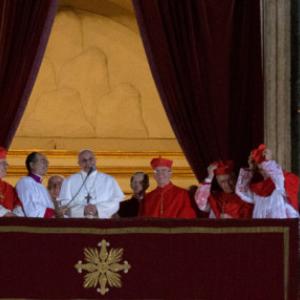
Newly elected Pope Francis appears on the central balcony of St. Peter’s Basilica. RNS photo by Andrea Sabbadini
VATICAN CITY — A hierarchy looking to make a clear statement about where the troubled church is headed chose on Wednesday the first member of the influential Jesuit order to be the next pope. Yet they also chose Cardinal Jorge Mario Bergoglio, a humble man who lives simply and took the name Francis (also a first) that evokes the founder of another great religious order.
The College of Cardinals picked the first non-European in modern times, as well – yet he is the son of Italian immigrants and grew up in Argentina, perhaps the most European of any country in Latin America.
And the cardinals above all wanted a pastoral figure who would project an image of vigor and warmth to the world after the eight-year reign of Pope Benedict XVI — an introverted, gaffe-prone German theologian who was 78 when he was elected and retired last month at 85, saddled by the burdens of this very public office.
Yet in his stead they chose a soft-spoken a 76-year-old who has been rapped for rarely cracking a smile — an image that Bergoglio did little to dispel with his low-key introduction as Pope Francis to the expectant crowd in St. Peter’s Square on a rainy Roman evening.
“Buona sera,” Francis said in deliberate, word perfect Italian, with just a slight Spanish accent. “You all know that the duty of the conclave was to give a bishop to Rome. It seems that my brother cardinals have come almost to the ends of the earth to get him … but here we are.”
So what, in fact, does the election of Francis say about the Catholic Church at this point in its history?
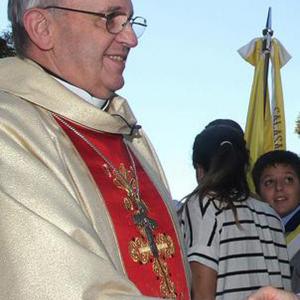
The new Pope Francis I, Cardinal Jorge Mario Bergoglio. Photo courtesy Religion News Service.
Argentinian Cardinal Jorge Mario Bergoglio was elected as Pope Francis I on Wednesday, after only two days of voting in the conclave tasked with choosing a successor to Pope Benedict XVI.
According to anonymous reports of the 2005 conclave, he was the leading contender against then-Cardinal Joseph Ratzinger, who became Benedict XVI. Bergoglio, 76, has served as the archbishop of Buenos Aires since 1998 and was made a cardinal in 2001. He is the first Latin American and the first Jesuit to rise to the papacy.
In his first address to the huge crowd that had gathered in St Peter’s Square, Francis asked for the prayers of “all men and women of good will” to help him lead the Catholic Church.
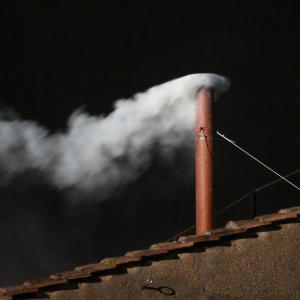
White smoke is seen from the roof of the Sistine Chapel, signaling a new pope. Peter Macdiarmid/Getty Images
White smoke billowed from the chimney atop the Vatican's Sistine Chapel on Wednesday, followed by bells ringing from St. Peter's Basilica — signaling the election of a successor to Pope Benedict XVI.
Jorge Cardinal Bergoglio, 76, current Archbishop of Buenos Aires, will be Pope Francis I.
It took just two days and four votes for the 115 members of the College of Cardinals to elect the new pope.
We will continue to update you as more information is released.
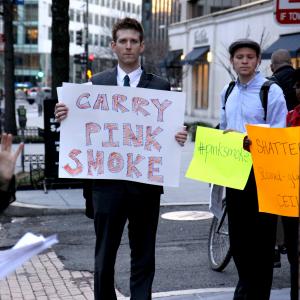
A Pink Smoke rallier holds a sign during prayers in downtown Washington, DC. Photo courtesy Ted Majdosz.
As cardinals in the Vatican wrapped up the first day of the conclave with no decision on the next pope, a small crowd assembled on the steps of the Cathedral of St Matthew the Apostle here in Washington, D.C., with signs, a guitar, and fervent prayers that the conclave would usher in a new openness to women in Catholic leadership.
The chilly March wind rose as volunteers passed around flickering candles. “There’s too much Holy Spirit here tonight,” one organizer joked. “We should tell her to tone it down a bit.”
Those assembled were praying for something popes have long opposed: an active recognition of women as decision-makers in the church.
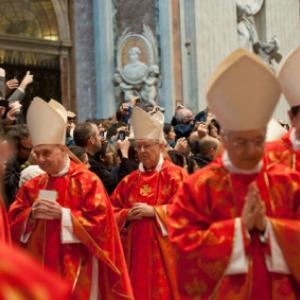
Cardinals enter mass at St. Peter’s basilica on March 12. RNS photo by Andrea Sabbadini
VATICAN CITY — As 115 cardinal-electors solemnly processed into the Sistine Chapel on Tuesday afternoon, with a cry of “Extra omnes!” and the latest high-tech jamming devices cutting them off from the world, the buzz outside the Vatican over who would eventually emerge as pope grew deafening.
Everyone had theories, many had favorites, and most declared it all so unpredictable that the winner – or even how long it would take to find him – was anybody’s guess.
“We are living through an extraordinary conclave,” Marco Tosatti wrote in La Stampa, the Italian daily whose insider coverage of the pre-conclave meetings read like a tip sheet for papal bookies.
“If we look at the history of conclaves over the last century, never has there been such a range of choices, and such uncertainty over the outcome up to the moment that the doors of the Sistine Chapel closed,” he said.
In fact, the latest lines were varied and morphing all the time, a feast of permutations for Vaticanisti who parse papal elections the way sci-fi geeks deconstruct a new installment of “Star Wars.”
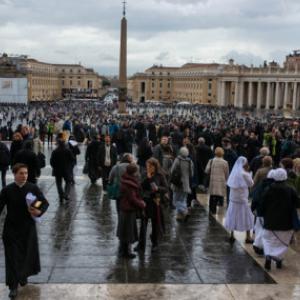
A view of St. Peter’s square on the first day of the conclave. RNS photo by Andrea Sabbadini
VATICAN CITY — Black smoke from the chimney atop the Sistine Chapel signaled that the first day of the conclave ended without the election of a new pope.
Even if the first-round outcome was largely expected, thousands of people on Tuesday braved the inclement Roman weather to wait for the result of the vote. They slowly filled up St. Peter’s Square as the evening progressed, with their eyes fixed on the small chimney.
Cries of disappointment erupted from the crowd when the black smoke appeared instead of the white smoke that would herald a successful election.

Cardinals attend the Pro Eligendo Romano Pontifice Mass at St Peter's Basilica Tuesday. Franco Origlia/Getty Images
VATICAN CITY — The doors of the Sistine Chapel closed behind the cardinals on Tuesday, marking the official start of the conclave that will elect the successor to Pope Benedict XVI.
The 115 cardinal-electors walked in procession into the Sistine Chapel, singing hymns and invoking the Holy Spirit, before filing under Michelangelo’s “Last Judgment” and taking a solemn oath of secrecy on everything that will happen during the conclave.
At the end of the oath-taking ceremony, the master of papal ceremonies, the Rev. Guido Marini, ordered the “extra omnes” (Latin for “everybody out”).
Cardinals will be sequestered inside a Vatican residence until a candidate receives the two-thirds majority needed for election to the papacy.
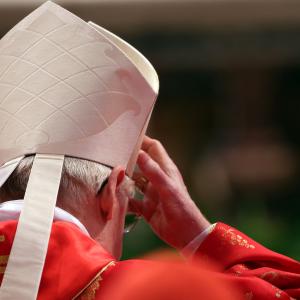
Cardinal Angelo Scola attends the Pro Eligendo Romano Pontifice Mass on Tuesday. Franco Origlia/Getty Images
As the College of Cardinals begins its conclave today in Rome to select the next Pope, I find myself intensely interested in the outcome. Since I am an Anabaptist, a child of the “radical” Reformation, I’ve spent some time reflecting on why that is so.
First, the Roman Catholic Church is an unbroken link to the first century Roman church for all Christians, no matter our denomination. Before the so-called “Great Schism” between the eastern and western church in 1054, the Christian church led from Rome was THE primary Christian church. No matter if we are Eastern or Western Christians, no matter how Protestant or Anabaptist some of us are, the Church of Rome is still in some way our Mother church.
Second, it remains the largest Christian tradition in the world.
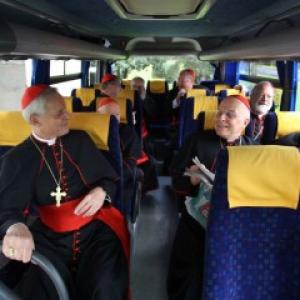
The American cardinals aboard the bus to Monday’s General Congregation. Photo courtesy Religion News Service.
As the Vatican prepares for the opening of the conclave today to elect a new pope, officials announced that the personal secretary of former Pope Benedict XVI will return to Rome for the first time since Benedict’s resignation on Feb. 28.
The Vatican’s chief spokesman, the Rev. Federico Lombardi, confirmed on Monday that Gaenswein will be one of the senior Vatican officials to take part in the solemn procession of cardinals into the Sistine Chapel that will open the conclave on Tuesday afternoon.Archbishop Georg Gaenswein, who was Benedict’s closest aide when he was pope, moved with Benedict to the papal summer residence of Castel Gandolfo when the retired pope left the Vatican on Feb. 28.
His presence will once again highlight the unprecedented situation — and potential complications — of having a retired pope still living just as cardinals gather to elect his successor.

The Sistine Chapel, where the conclave is taking place. Photo courtesy Religion News Service.
As if the task of choosing the Vicar of Christ and the leader of the world’s 1.2 billion Catholics wasn’t daunting enough, the voting must also take place under the gaze of Michelangelo’s brilliant but imposing frescoes in the Sistine Chapel.
That’s what the late Pope John Paul II decreed when he rewrote the conclave rules in 1996, and so it shall be starting today — and for however many days it takes the 115 cardinal-electors to choose a successor to Pope Emeritus Benedict XVI, who retired last month.
In the Sistine Chapel, “everything is conducive to an awareness of the presence of God, in whose sight each person will one day be judged,” John Paul II wrote in his 1996 Apostolic Constitution “Universi Dominici Gregis,” which regulates papal elections.
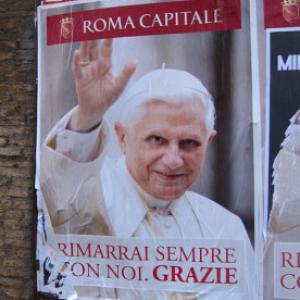
A poster of Pope Benedict XVI on the streets of Rome. The conclave will begin on Tuesday. RNS photo by David Gibson
VATICAN CITY — Amid all of the prognosticating about who the cardinals could choose as the next pope in the conclave that starts here on Tuesday, one reliable thread has emerged: the desire to elect a pontiff who can be a pastor to the world as well as a taskmaster to the Roman Curia.
Finding such a combination in a single man, of course, may prove difficult if not impossible, which adds to the almost unprecedented level of uncertainty surrounding this papal election.
So if anything is possible, some say it might be better to reverse the prevailing wisdom — look for a pope who will talk tough to Catholics (and the world) while shepherding the Curia with a firm hand in order to better police the wayward.
The prospect might appall progressives and others who were happy to see the end of Pope Benedict XVI’s papacy, but it has enough appeal to conservatives that they are trying to make the case.
One reason for their sense of urgency is that Cardinal Joseph Ratzinger turned out to be more of a papal pussycat as Benedict XVI than the watchdog of orthodoxy that he had been for decades while serving under John Paul II.
Is now the time for a pope who could be more of a Ratzinger than a Benedict?
VATICAN CITY — The conclave to pick a new pope will begin on Tuesday the Vatican said on Friday, resolving an open question that had dogged the cardinals meeting here over the past week.
The cardinals will celebrate a special Mass “pro eligendo Romano Pontifice” — for the election of the Roman Pontiff — in St. Peter’s Basilica on Tuesday morning, and in the afternoon the cardinals will enter into the Conclave, the Vatican said.
The date was set by the cardinals gathered in a late-afternoon session on Friday. They were scheduled to vote on the decision, but there was no word on how many supported the Tuesday start date or how many preferred an earlier or a later date.
In one of his last acts before resigning on Feb. 28, Pope Benedict XVI amended the law regulating papal elections to allow cardinals to move up the beginning of the conclave, which would normally not be able to start until at least 15 days after a pope dies or leaves office.
Because Benedict resigned — the first pope to do so in 600 years — and announced his plans on Feb. 11, the cardinals did not have to focus on a funeral, as they did when John Paul II died in April 2005. They also have had nearly a month to think about a successor.
As a result, many believed the cardinals did not need to wait long after Benedict’s resignation took effect to begin the conclave itself.
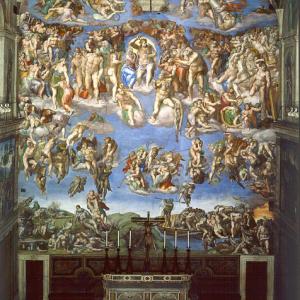
Interior of the Sistine Chapel. Photo courtesy RNS / Wikimedia Commons / Public Domain
In Catholic theology, as in the popular imagination, the closed-door conclave to elect a new pope is supposed to be guided by the Holy Spirit.
There’s no horse-trading or lobbying, no insider deal-making or outside influences allowed. Just red-robed cardinals solemnly entering the Sistine Chapel, accompanied only by prayers and their consciences, sitting beneath Michelangelo’s fresco of the Last Judgment and discerning God’s will on who should be the next successor to St. Peter.
At least that’s the theory. The last millennium has shown that papal elections can be fraught with politics or worse, and can take months or even years of wrangling to reach a resolution.
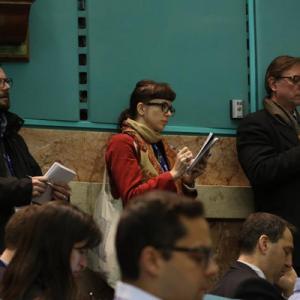
Reporters listen as cardinals speak to the press in the Vatican Tuesday. Photo courtesy Religion News Service.
Tensions among the Roman Catholic cardinals meeting here to choose a new pope appeared to escalate on Wednesday as the American prelates in Rome canceled their daily press briefing under pressure from colleagues who are frustrated over news coverage of their secret talks.
The cardinals also announced that they still had not been able to agree on a start date for the conclave, in which 115 electors will cast their ballots for a successor to Pope Benedict XVI.
The effort to control the flow of information from the daily pre-conclave “General Congregation” meetings marked a sharp reversal from the unprecedented openness that had characterized this first papal conclave of the digital age.
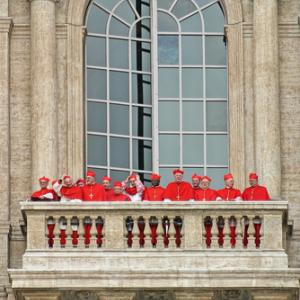
Cardinals at the papal conclave in April 2005. Photo courtesy Rostislav Glinsky/shutterstock.com
“In the church,” Chicago Cardinal Francis George once said, “everything has happened at least once!” That’s no surprise given that the Catholic Church is a nearly 2,000-year-old institution that has adapted to radically different epochs.
But electing a new pope while the former pope is still alive? That’s rare.
So what are some other firsts and lasts, quirks and facts of papal history that you should know? There are plenty, and Religion News Service has compiled a handy guide.

Cardinal Sean P. O’Malley celebrates Sunady Mass on March 3, 2013. Photo courtesy Religion News Service.
Roman Catholic cardinals on Monday met for the first of a series of closed-door meetings in the run-up to the conclave that will elect the successor to former Pope Benedict XVI.
But as cardinals filed into a Vatican conference room under the gaze of dozens of cameras, church officials said 12 voting prelates still haven’t arrived in Rome, pushing back the possibility of an early start to the conclave.

Vatican City at night, Vladimir Mucibabic / Shutterstock.com
The Vatican appears rocked by scandalous rumors and resignations just as church leaders must gear up to replace frail Pope Benedict XVI with a closed-door conclave.
But Vatican experts say if you think the world’s largest nongovernmental institution is in unprecedented chaos right now, think again.
Vatican Secretary of State Cardinal Angelo Sodano presents the papal fisherman ring to Pope Benedict XVI at the new pope’s installation Mass. The fisherman’s ring bears an image of Peter, his boat and his net, which figure in two Gospel accounts of miraculous catches of fish. Benedict said that while fish die when removed from the sea, “in the mission of a fisher of men the reverse is true.”
“Have you ever heard of the Borgias?” quipped professor Terrence Tilley, chairman of the theology department for Fordham University in New York. They were the larcenous, adulterous, murderous, election-rigging, Renaissance-era family of renaissance popes “who ran the papacy for decades like a private fief.”
For all the sex, money, and power headlines wafting out of Rome these days, at least no one has been murdered. Infighting and innuendo, though, are ancient traditions that have moved into the bright lights of the 24/7 news cycle and social media.
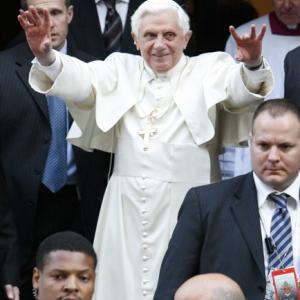
Pope Benedict XVI. RNS photo courtesy Gregory A. Shemitz.
In his final public address, Pope Benedict XVI on Wednesday forcefully defended his decision to resign while trying to reassure Catholics still reeling from the shock of his unprecedented move.
For the first time since his stunning announcement on Feb. 11, the 85-year-old pope explained at length his decision to become the first pope in six centuries to resign. His tenure officially ends Thursday at 8 p.m. local time.
Benedict admitted that his resignation is a “grave” and “novel” act but, he added, his choice had been made “with profound serenity.”
“Loving the church means having the courage to make difficult, agonizing choices, having ever before oneself the good of the church and not one’s own,” he said.